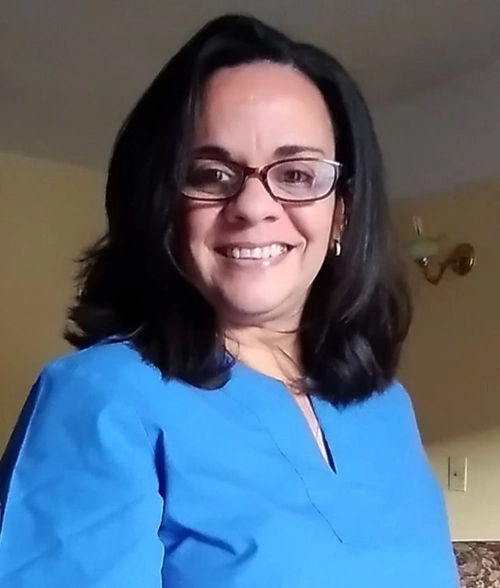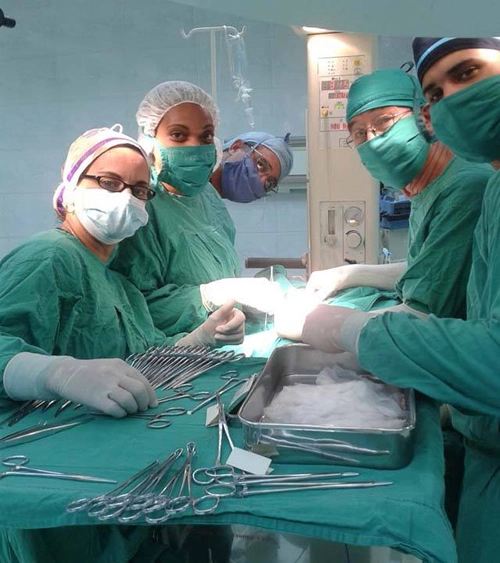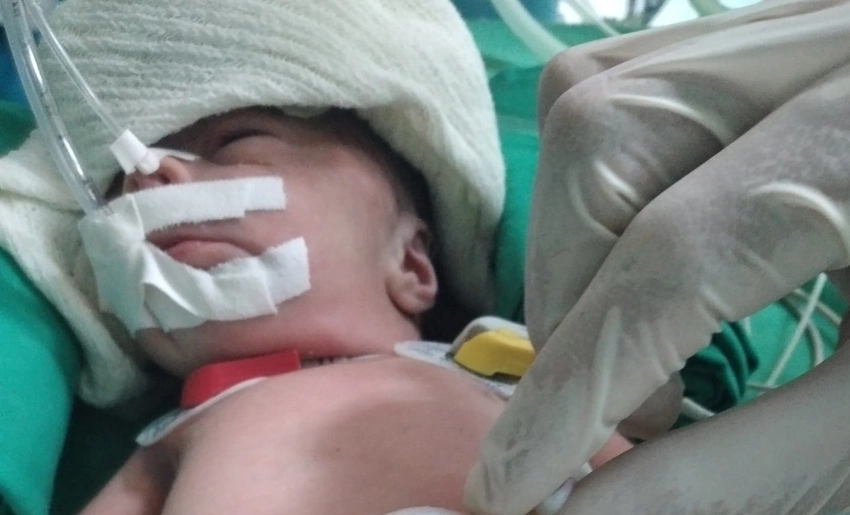Yanet Hidalgo Marrero, Doctor in Medical Sciences, pediatric surgeon, second degree specialist and head of the Pediatric Surgery Service of Octavio de la Concepcion de la Pedraja Hospital in Holguin, is always seen affable, casual, like someone who emerges victorious from an attack against death, always pending of her responsibilities and profession, in short, bearer of light.
At all times she is aware of the most critical surgical cases, of the evolutionary X-rays, of the health of those who are for her like a big family because from the moment they arrive to this world, together with her multidisciplinary team, they welcome them and watch over them minute by minute so that they continue to live.
And there is indeed a lot of work, sacrifice and sleepless nights in the results shown by the Regional Neonatal Surgery Center (CRCN) in Holguin. The one hundred percent survival rate in the 22 cases operated on with congenital malformations in the whole Eastern region and Camagüey province all along last year is not the result of chances, but of a well protocolized work dynamics defended against all odds.
Although this story is told by one of its protagonists, it could be that of any other of the many anonymous heroes we find there, contributing their knowledge to the life of the little ones.
Dr. Yanet Hidalgo Marrero, Holguin

How much work is behind the results obtained by the Regional Center for Neonatal Surgery during the year 2023?
“During year 2023 at the CRCN we continued working with the neonatal surgery of all the patients of the Eastern region, that is to say, we also assistted all the congenital malformations of surgical nature that required some procedure for their repair, with the particularity that as of 2023 we were joined by the province of Camagüey. Due to the current situation and the need to improve the survival of these patients, both complex and less complex malformations, we have taken on the idea that by regionalizing this attention, resources and supplies will also be regionalized.
“We have a vastly experienced staff, both from the neonatological point of view, as well as the surgical and nursing staff. This makes it easier, more practical and efficient to regionalize care and offer high standards in the quality of surgical care.
“It has not been easy because, just as there is a lack of all kinds of supplies in public health in all the regions of the country, we lack resources, but it is a very personalized attention and the number of patients is not so large. Although it includes six provinces, last year we only had 22 surgical patients and we were able to guarantee all the resources, from the point of view of surgical material, sutures, probes, parenteral solutions.
What strengths do you have to take on such delicate medical assistance?
“We were also able to do so thanks to the existence of a multidisciplinary team. We are a great team at the CRCN with specialized nursing care, Doctors of Medical Science, professors with vast experience in neonatal intensive care, which is practically the basis of surgical care. The center is based in our Pediatric Surgery Service in Holguin, which has 40 years of experience in pediatric and neonatal surgery, with a high survival rate over the years.
“This means that we have very experienced professors and with the help of young surgeons who, over the years, have become familiar with and the teachings from our professors, to maintain these results. The Regional Center is also a teaching and research center. And something that we have achieved and has allowed this result is the protocolization of the norms and procedures that are performed there. In other words, by working in such a standardized and organized way, it allows for more specialized care.
“This includes from the birth of the patient in his province, taking into account the very well medicalized sanitary transfer, with specialists also of high standard, to the reception, the preparatory stabilization of the patient, the surgical act itself, which also includes the Anesthesiology service of our hospital and the Regional Center, a service with a lot of experience and that always supports the surgical act.
“At present, we are a service also made up of young people, where all these young surgeons are in constant training, we even receive residents and specialists from Santiago de Cuba, Guantánamo, Las Tunas and Grama, who do their neonatal surgery training here”.
The specialists of this center are highly skilled in caring for patients with esophageal atresia. How do they do it?
Neonatal surgery, Holguín

“Esophageal atresia is one of the most frequent congenital malformations within our region, in which we have a vast experience and an excellent survival rate in the last decade because it is very well protocolized, we have even published in an international journal this protocol that has been well accepted.
“The results speak of the team’s experience because we were able to perform a very high percentage of primary esophageal repair, because esophageal atresia is when the baby does not have continuity of the esophageal lumen, that is, he/she cannot feed through the normal route, which is the mouth. And in that case we have a high rate of reconstruction, of esophageal repair through primary anastomosis and we have our protocols designed to save the primary esophagus, even if the baby’s conditions do not allow an initial repair”.
When patients are no longer neonates, how are they followed up?
“All the conditions treated here have a follow-up section in their protocol. We do not abandon patients, not even when they come from distant provinces such as Santiago de Cuba or Guantanamo. We keep a strict follow-up of those newborns who have survived their congenital malformation, who have undergone surgery during their first year of life at our Regional Center. And through very specialized consultations that include even the sanitary transfer to our center, guaranteed by the Ministry of Health, with its specialist and nurses.
“These children are not left to their own devices, they do not travel on their own, through public transportation. Their family is in constant contact with the specialists who performed the surgery and they come monthly during the first year of life. Last year, the operated newborn often has to be reoperated for the definitive operation or needs very specific procedures such as contrasts, tomographies, other studies to check the functioning of his digestive tract, his/her neurological part, his neurodevelopment, closures of some ostomies that are pending, the nutritional development that is very important in the case of surgical newborns.
“Therefore, a multidisciplinary team works for the follow-up of these patients in close interrelation with the surgeons of the provinces because in the case of pediatric surgery we are a big family in the whole country, a teaching training center for neonatal surgery.”
“The child is in constant communication with us, he comes and goes from his provinces when he is able to travel and generally after the first year of life he/she can incorporate himself/herself to his/her normal physical activity. And in that we have gained a lot with the protocolization, also the follow-up includes the quality of life we offer to that patient, because the surgical patient is not only to operate, to reestablish the anatomical continuity, it is to achieve that the functioning of that organ in the long term is adequate.
“We do not want the child to reach school age with a colostomy, because it is very complex, it brings a lot of psychological trauma. We intend to reincorporate the child into normal life, without anatomical, functional or psychological sequelae, which surgery implies at such an early age”.
- Systemic Sclerosis, a Disease in Need of Publicity - 1 de July de 2025
- Holguin with the first Center for Research Resources in Health - 28 de June de 2025
- Activities in Holguin for the International Day against Drug Abuse - 26 de June de 2025

